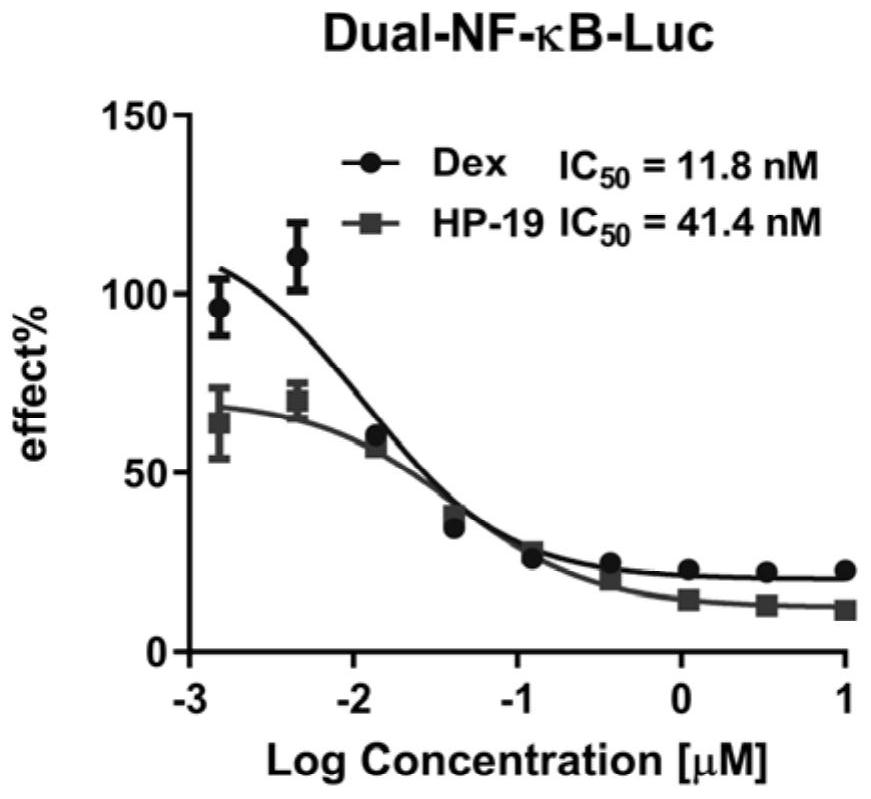Sulfonamide compound and application thereof in preparation of medicine for treating autoimmune diseases
An autoimmune and compound technology, applied in the field of medicine, can solve problems such as glucose intolerance, and achieve the effect of potential application value
- Summary
- Abstract
- Description
- Claims
- Application Information
AI Technical Summary
Problems solved by technology
Method used
Image
Examples
Embodiment 1
[0074] 1. Structure-based virtual screening
[0075] Experimental principle: Use structure-based virtual screening to predict the binding mode and binding free energy between compounds in the compound database and glucocorticoid receptors, and screen small molecule compounds that can bind to glucocorticoid receptors.
[0076] Experimental method: Based on the crystal structure of the glucocorticoid receptor (PDB number: 6EL9), the Glide molecular docking module of the Schrodinger molecular simulation software package was used to conduct a structure-based virtual screening of the chemdiv small molecule database, and the best 3000 compounds were scored. Conformational analysis was performed and 88 compounds were finally purchased for activity screening.
[0077] Experimental results: 24 potential glucocorticoid analogs were screened and had different chemical backbones ( figure 1 ).
[0078] 2. Evaluation experiment of anti-inflammatory ability of glucocorticoid receptor
[0...
Embodiment 2
[0118] Taking HP-19 as the lead compound, the analogs were obtained in two ways: 1) The analogs containing N-phenylbenzenesulfonamide were selected in the Chemdiv compound library, and the binding mode of the compound and GR was predicted by molecular docking. Anti-inflammatory activity evaluation; 2) According to preliminary structure-activity relationship, order or synthesize compounds. The specific implementation is as follows:
[0119] Concrete reaction conditions and synthetic route are as follows:
[0120] Reaction Route 1:
[0121]
[0122] Wherein, the substituent R=-CH at any position on the benzene ring 3 , -F, -OCH 3
[0123] Obtainment of 6-nitro-1,2,3,4-tetrahydroquinoline:
[0124] 6-Nitroquinoline (1.74 g, 10 mmol), Hantatzsch ester (6.33 g, 25.0 mmol) and B(OH) 3 (123.6 mg, 2.0 mmol) was placed in a 250 mL single-neck bottle, and 100 mL of dichloroethane DCE was added as a solvent. The reaction was heated to 60°C overnight. After spotting the disappe...
Embodiment 3
[0206] Example 3: Evaluation of HP-19 Based Analog Activity
[0207] Taking HP-19 as the lead compound, we obtained a total of 24 compounds. As shown in Tables 1 and 2, the transcriptional inhibitory activity of most compounds against NF-kb was greater than 50% at 10 μM dosing. For N-phenylsulfonamide compounds, only one HP-26 (ChemDiv ID: V016-8573) was purchased due to fewer skeleton types in the compound library. The activity evaluation is as follows:
[0208]
[0209] Table 1 Inhibitory activity of N-phenylsulfonamide compounds (1) on NF-κB transcription level
[0210]
[0211]
[0212]
[0213]
[0214] Table 2 Inhibitory activity of N-phenylsulfonamide compounds (2) on NF-κB transcription level
[0215]
PUM
 Login to View More
Login to View More Abstract
Description
Claims
Application Information
 Login to View More
Login to View More - R&D
- Intellectual Property
- Life Sciences
- Materials
- Tech Scout
- Unparalleled Data Quality
- Higher Quality Content
- 60% Fewer Hallucinations
Browse by: Latest US Patents, China's latest patents, Technical Efficacy Thesaurus, Application Domain, Technology Topic, Popular Technical Reports.
© 2025 PatSnap. All rights reserved.Legal|Privacy policy|Modern Slavery Act Transparency Statement|Sitemap|About US| Contact US: help@patsnap.com



